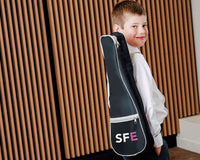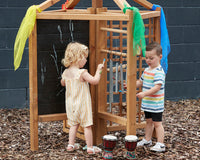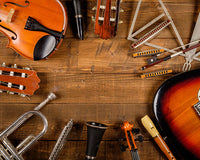So, which is better? A traditional Brass Trombone, or a plastic pBone? You won’t get this debate on Newsnight!
To have a fair and justifiable debate, I will split it into categories that every Trombonist will appreciate and strive for: Build. Tone. Articulation. Intonation. Cost.
Check out our full range of trombones: HERE!
Build
- The pBone is extraordinarily strong. The ABS one-piece bell and fibre glass slide won’t dent if knocked or dropped like a traditional brass trombone, allowing beginners to play without the fear of damaging the instrument.
- It is extremely lightweight, 1.75kg as opposed to the 5 - 7kg of the average traditional brass model.
- It's very easy for younger players to support and play, and the slide is basically maintenance free.
- You can get pBones in a vast range of colours. A traditional Trombone takes many hours of hand-made expertise to manufacture, using only the finest of resonant brass alloys.
- The lacquered finish of brass enhances the beautiful gold quality, and the weight distribution results in a perfectly balanced feel and performance. You know that when you play this, you have an object of desire and musical perfection supporting you.

Tone
- The ‘mighty’ Trombone is synonymous with tonal perfection. No valves (generally!) to hinder the sound production. No compressed tapered reeds to bite on. No equine hair to scrape across! Doesn’t need hitting!! Pure and simple. Majestic and resonant.
- I will admit, I was sceptical of the pBone when I first set eyes on it. Plastic; could it ever get near to the sonorous, tonal depth I sought and practised for religiously?
- Well actually, and surprisingly, it can! Get near, that is!! The ability to get a full and rewarding sound across the registers can be achieved. Especially as it comes with two mouthpieces; an 11C and a 6.5AL. Made of plastic, of course. The tone is definitely better at mf-f as opposed to a subtle pp or ff dynamic marking. Plus, if you use a traditional small shank mouthpiece, it will also improve the tone.
- As you might imagine. The tone achieved from a brass Trombone is far, far superior and more consistent. This can also be enhanced by opting for a trombone made of different brass alloys; ratio of copper to zinc in its formulation.
- The high quality brass metal used to produce a trombone produces a naturally warmer and brighter tone. The result; a crispness, clarity, projection and depth not achievable on a ‘pInstrument’.
Articulation
- Whether you use the plastic mouthpiece, or your regular, small shank brass mouthpiece on a pBone, you can produce a fluid and sufficient articulation during intricate passages of music.
- Due to the plastic bell resonance and fibre-glass slide however, it can be inconsistent and sometimes a hindrance in the most ‘tricky’ of passages. The slide cannot compete with the precision engineered slide on a Montreux, Elkhart, or the Yamaha Trombone.
- These are much quieter, smoother and reassuring throughout any challenging works. Yes, they need maintenance and care, but the rewards are worth every drop of Rapid Comfort Slide Oil!
Intonation
- All of our excellent new Brass Trombones are perfect when it comes to intonation.
- More often than not, when I hear someone playing out of tune, it is always down to technique or fatigue, and never the actual trombone. Poor embouchure, too much pressure, overblowing, and not understanding slide positional alterations in the higher register are all possible causes.
- The design and production of even the cheapest brass Trombones we offer, allows players of all abilities to succeed.
- The pBone however does have a slight deficiency over its brass counterpart in its intonation, especially at higher volumes and pitch. But generally speaking, unless you really overblow, intonation is secure.

Cost
- The brass Montreux Student Trombone is just over £200! Yet it is more than capable of taking a player up to the mid to high grades. It is also very adept at tackling 1st Trombone parts in a Big Band. Super ‘F’s’; no problem!
- My favourite, due to its versatility and quality, is the Elkhart 100 Series. Professional, consistent results from its gold brass construction produces a deep, warm sound. The small shank mouthpiece onto a medium/large bore offers a range and projection desired by most. And all this high-end quality for just £400!
- However, if a College of Music beckons and the possibility of an Orchestral professional career is on the horizon, the Yamaha YSL354 must be on your shortlist. The YSL354 is unquestionably the best specification trombone on our website. Bullet-proof build quality and superior raw materials put this instrument in a category of its own. For under £1k!
- Now, as you are reading this, I can only imagine that you have done a bit of research yourself, and know that the pBone costs a fraction over £100. Amazing value for money when you think that here is a fully competent instrument that can produce wonderful sounds.
- Agreed, it may look out of place on a Championship Brass Band stage, or within a Symphonic Orchestra. It would struggle with Ravel’s Bolero or Sibelius’ Finlandia. And, it can’t match the depth of tone or quality of those trombones costing 20 times more. But that’s the point.
- They are fun, capable, cheap, lightweight and almost indestructible! And, did I mention, you can get them in lots of wonderful colours?
- They look brilliant on stage, in schools, in bands, outside, in photos, and we can offer them discounted if you buy ‘whole’ class sets. They are highly regarded by all ages!





















